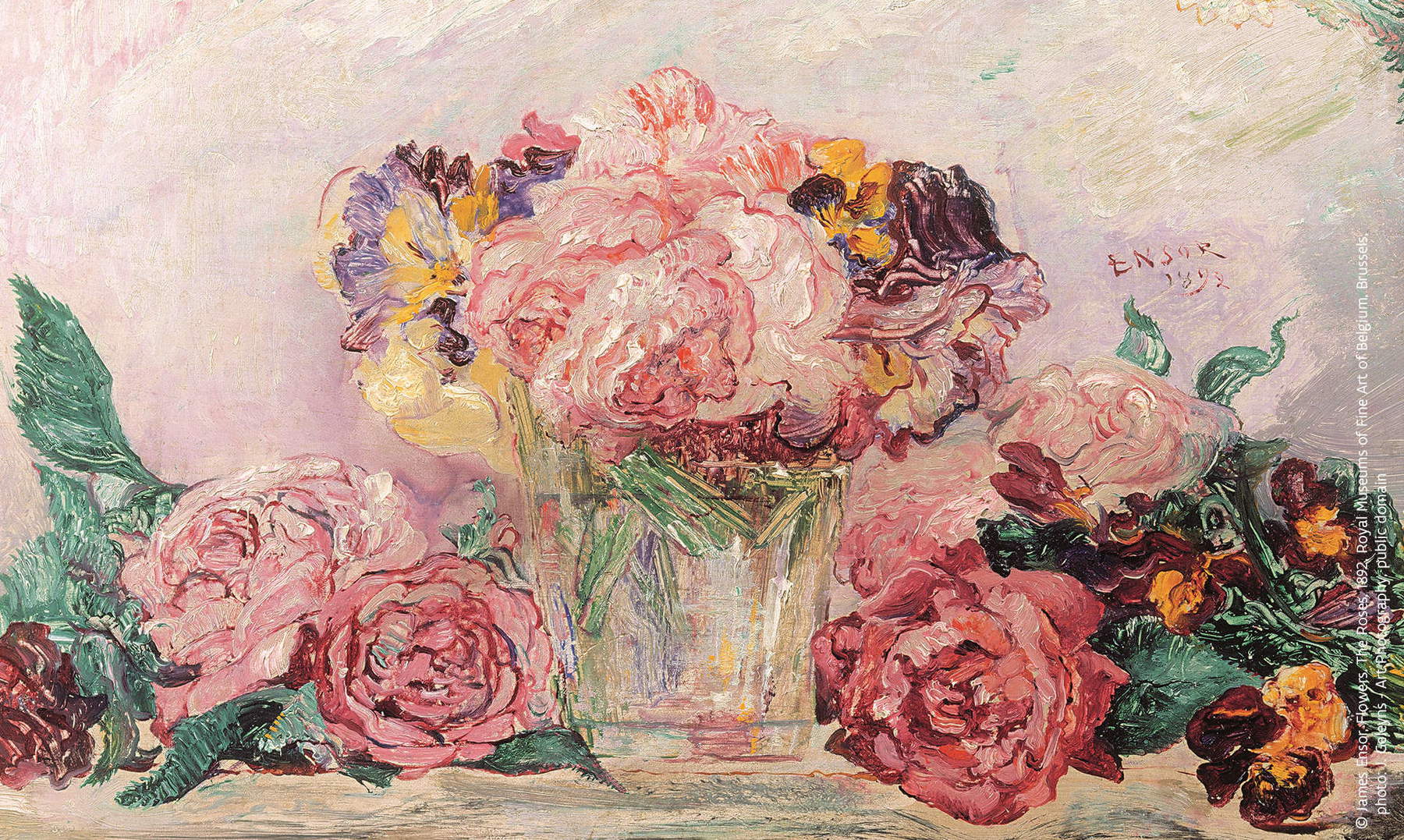In Belgium, Flanders is preparing to dedicate the whole of 2024 to one of the greatest painters in the country’s history, James Ensor (Ostend, 1860 - 1949), and it does so starting from his city, Ostend, where from December 16, 2023 to April 14, 2024, the exhibition Rose, Rose, Rose à mes yeux is being held at Mu.Zee. James Ensor and Still Life in Belgium 1830-1930. The exhibition, curated by Bart Verschaffel and Sabine Taevernier assisted by Stefan Huygebaert, is a preview devoted entirely to the still life of James Ensor. Some fifty paintings from Ensor’s eminent production in this area, from early bourgeois examples to the “ghostly” still lifes of the 1990s to the ethereal, dreamlike examples of his last period, serve as the backbone and reference for an overview of still life in Belgium between 1830 and 1930. In this century, several talented painters sought ways in which to breathe new life into this genre, which had been reduced to something flashy and decorative, lacking in artistic vein, both pictorially and iconographically. Ensor illustrates both its general development and its exceptional quality.
James Ensor can, rightly, be considered an innovator, an important link between the artists of the 19th century and the modernists. Together with contemporaries such as Edvard Munch, Claude Monet, or Odilon Redon, he belongs to the ranks of19th-century European avant-garde artists: their work represents a connecting moment in the history of European art and is therefore fundamental to a better understanding of the birth and development of modernism during the 20th century. Rose, Rose, Rose à mes yeux. James Ensor and Still Life in Belgium 1830 - 1930 also and above all offers an overview of the academic and decorative tradition of the 19th century from David De Noter to Frans Mortelmans, with several forgotten but highly talented painters who achieved great success during their era, such as Jean Robie and Hubert Bellis. Special attention is given to completely forgotten female painters such as Alice Ronner and Georgette Meunier, as well as the isolated figure of Henri De Braekeleer. Then follows a selection of painters who, already within the accepted tradition of modernism, devoted themselves to still life, yet without betraying the canons of the genre, such as Louis Thevenet and Albert Saverys. There are also some painters who, just like Ensor, through their painterly approach and construction of the image, create extremely individual and strong images, such as Léon Spilliaert, Rik Wouters, Gustave Van de Woestyne, and Walter Vaes. The exhibition concludes with artists who expand to the point of almost exploding the fixed image space of the “theater of things”-Jean Brusselmans, René Magritte, Marthe Donas, and Frits Van den Berghe. The exhibition welcomes works on loan from, but not limited to, the Kunsthalle Mannheim, the Basel Museum of Art, the Boijmans Van Beuningen Museum in Rotterdam, the Musée d’Orsay in Paris, the Museum of Fine Arts in Ghent, our two museum partners the Royal Museums of Fine Arts of Belgium in Brussels and the Royal Museum of Fine Arts in Antwerp, as well as numerous public institutions and private collections from the Netherlands, France, Germany, Switzerland, Austria and Munich.
"Nearly thirty years after the exhibition Belgische stilleven- & bloemenschilderkunst (Floral and Still Life Painting of Belgium) 1750 -1914 (October 1994 - January 1995), curated by Norbert Hostyn in the then Museum of Fine Arts in Ostend," explains Dominique Savelkoul, director of Mu.ZEE, “our museum once again becomes the place to discover painted still life. At the same time, this exhibition allows visitors to discover works that propose still life in a different way, that challenge the genre, both in form and content. In this way, the exhibition, just like the accompanying catalog, evokes artists whose names have often been forgotten, just like their works. Still life was a domestic genre that thrived in the private sphere, to which even ”women artists,“ excluded from the art academy and the public sphere, devoted themselves body and soul, and through which they created their professional environment as artists, including the Cercle des Femmes Peintres (1888-93). It is, therefore, with pride that we compare works by Berthe Art, Louise De Hem, Georgette Meunier and other women artists with the still lifes of Ensor and other fellow artists. Their presence, and in some cases rediscovery, is perfectly consistent with Mu.ZEE’s ambition, focusing on Belgian art from the 1880s to the present, to promote women who have made art history never before. It is therefore encouraging that for this exhibition Mu.ZEE can count on the generous support of the Marlein Fund, just as the Friends of Mu.ZEE can rely on the support of the National Lottery.”
On the occasion of Rose, Rose, Rose à mes yeux. James Ensor and Still Life in Belgium 1830 - 1930, a “last exhibition” in anticipation of the upcoming renovation of the museum building, architects Kris Coremans and Guy Châtel have created a special set design that creates a foreground for the exhibition, relegating the many spatial accidents of the current building behind the scenes. The set design compares the former warehouse that houses Mu.ZEE with the 19th-century museum model.
Finally, on the occasion of the exhibition, the Mercatorfonds publishing house is publishing a catalog of the same name, containing not only an overview of the works on display, but also contributions on the significance of still life in the work of James Ensor and the history of still life in Belgium. The catalog is available in Dutch, French or English and can be purchased at the Mu.ZEE store for €45.
 |
| Belgium, an exhibition on James Ensor and still life in Ostend |
Warning: the translation into English of the original Italian article was created using automatic tools. We undertake to review all articles, but we do not guarantee the total absence of inaccuracies in the translation due to the program. You can find the original by clicking on the ITA button. If you find any mistake,please contact us.